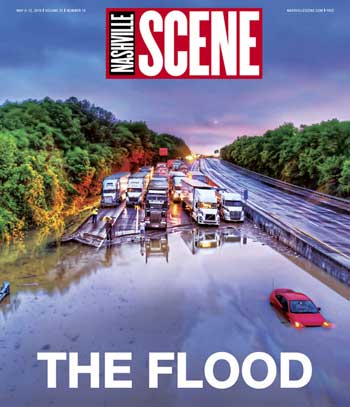
Nashville Scene, our sister publication offers an introspective collection of articles with perspective on life changing events this week in Nashville’s history. Be sure to pick up the issue, and also click on the link at the bottom of this page to see a 45-slide Flood retrospective. —DMR
• • • • •
This is not the city we lived in five days ago.
We woke last Saturday morning — May 1, 2010, the ominously designated May Day — to a sky the color of a livid bruise and rain that steadily increased from strong to torrential. It didn’t let up. By late afternoon, a children’s birthday party at the Hillwood Strike & Spare near Bellevue let out to a sky split by lightning and rivulets swelling into whitewater.
In Antioch, motorists on I-24 realized too late that an impossibility had overtaken them — symbolized by the sight of an uprooted portable building lumbering into view like a ghost ship. In Germantown, in Bordeaux, in Antioch, where the roiling Mill Creek brought traffic to a standstill, the waters churned. In Franklin, homeowners along the Harpeth watched the river rise with terrifying speed. “It was like something alive,” one said.
By Sunday afternoon, two realizations set in, equally chilling. The disaster befalling Tennessee was worse than anyone could possibly have imagined — and yet we had no idea how bad it would get.
Those of us with power watched as the unthinkable happened again and again on live TV. Or we followed updates chasing the lightning on a buzzing web of electronic media — a support network emerging from isolated pinpricks. Those without watched helplessly as their homes and belongings washed away, their cars, their keepsakes, their family photos. Entire communities were devastated. Nashville, for all practical purposes, became an island.

About the Author
David M. Ross has been covering Nashville's music industry for over 25 years. dross@musicrow.comView Author Profile



